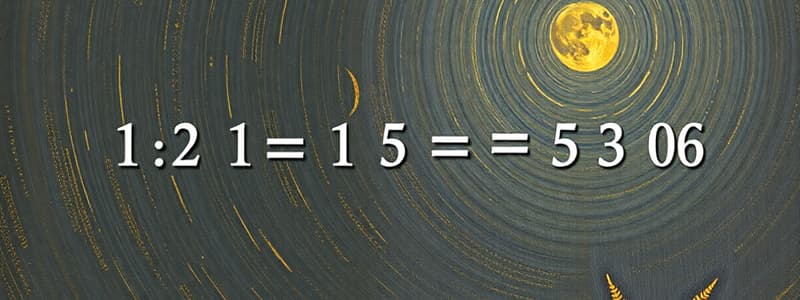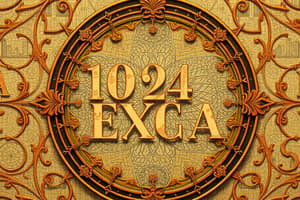Podcast
Questions and Answers
When converting a fraction to a decimal, what determines whether the resulting decimal will be terminating or repeating?
When converting a fraction to a decimal, what determines whether the resulting decimal will be terminating or repeating?
- Whether the numerator is divisible by the denominator.
- The size of the numerator.
- The size of the denominator.
- Whether the denominator's prime factors only include 2 and 5. (correct)
The decimal 0.33 is equivalent to the fraction 1/3.
The decimal 0.33 is equivalent to the fraction 1/3.
False (B)
What is the place value of the digit 7 in the decimal number 12.3478?
What is the place value of the digit 7 in the decimal number 12.3478?
thousandths
When comparing decimals, if the whole number parts are equal, you compare the digits in the ______ place first.
When comparing decimals, if the whole number parts are equal, you compare the digits in the ______ place first.
Match the following decimals with their equivalent fraction form (simplified):
Match the following decimals with their equivalent fraction form (simplified):
Which of the following statements accurately describes how to compare two decimal numbers?
Which of the following statements accurately describes how to compare two decimal numbers?
Non-terminating, non-repeating decimals can always be expressed as a fraction.
Non-terminating, non-repeating decimals can always be expressed as a fraction.
Explain how to convert the terminating decimal 0.625 into its fractional form. What is that fractional form in its simplest terms?
Explain how to convert the terminating decimal 0.625 into its fractional form. What is that fractional form in its simplest terms?
What is the result of rounding 12.3456 to three decimal places?
What is the result of rounding 12.3456 to three decimal places?
When subtracting decimals, it is not necessary to align the decimal points vertically as long as you keep track of the number of decimal places.
When subtracting decimals, it is not necessary to align the decimal points vertically as long as you keep track of the number of decimal places.
Calculate the sum of 2.35, 1.05, and 0.1.
Calculate the sum of 2.35, 1.05, and 0.1.
To convert the decimal 0.65 into a percentage, multiply it by _______.
To convert the decimal 0.65 into a percentage, multiply it by _______.
Match the decimal operations with their respective examples:
Match the decimal operations with their respective examples:
What is the result of the following calculation: $5.25 \div 0.5$?
What is the result of the following calculation: $5.25 \div 0.5$?
What is 7/8 expressed as a decimal?
What is 7/8 expressed as a decimal?
In engineering, why are decimals used in design calculations?
In engineering, why are decimals used in design calculations?
Flashcards
What are decimals?
What are decimals?
Numbers in base-10 using place value to represent fractions. They consist of a whole number, a decimal point, and a fractional part.
What is place value?
What is place value?
The value of a digit based on its position in a number (ones, tens, hundreds, tenths, hundredths, etc.)
How do you read decimals?
How do you read decimals?
- Read the whole number. 2. Say 'point' or 'and'. 3. Read digits after the decimal as a whole number. 4. State the place value of the last digit.
What are terminating decimals?
What are terminating decimals?
Signup and view all the flashcards
What are repeating decimals?
What are repeating decimals?
Signup and view all the flashcards
How do you convert a fraction to a decimal?
How do you convert a fraction to a decimal?
Signup and view all the flashcards
How do you convert decimals to fractions?
How do you convert decimals to fractions?
Signup and view all the flashcards
How do you compare decimals?
How do you compare decimals?
Signup and view all the flashcards
Rounding Rule
Rounding Rule
Signup and view all the flashcards
Adding Decimals
Adding Decimals
Signup and view all the flashcards
Subtracting Decimals
Subtracting Decimals
Signup and view all the flashcards
Multiplying Decimals
Multiplying Decimals
Signup and view all the flashcards
Dividing Decimals
Dividing Decimals
Signup and view all the flashcards
Decimal to Percentage
Decimal to Percentage
Signup and view all the flashcards
Percentage to Decimal
Percentage to Decimal
Signup and view all the flashcards
Decimal Applications
Decimal Applications
Signup and view all the flashcards
Study Notes
Definition
- Decimals are numbers in the base-10 system, using place value to represent fractions.
- Decimals include a whole number part, a decimal point, and a fractional part.
- The decimal point separates the whole number from the fractional component.
Place Value
- Each digit in a decimal has a specific place value.
- Place values to the left of the decimal point include ones, tens, and hundreds.
- Place values to the right of the decimal point include tenths, hundredths, and thousandths.
- Each position to the right of the decimal point represents a power of 1/10.
- In the number 123.456, 1 is in the hundreds place, 2 is in the tens place, 3 is in the ones place, 4 is in the tenths place, 5 is in the hundredths place, and 6 is in the thousandths place.
Reading Decimals
- The whole number part should be read normally.
- "Point" or "and" should be said at the decimal point.
- Digits after the decimal point are read as a whole number.
- It's important to state the place value of the last digit.
- For example, 3.14 can be read as "three point one four" or "three and fourteen hundredths."
- 0.25 can be read as "zero point two five" or "twenty-five hundredths."
Types of Decimals
- Terminating decimals feature a finite number of digits.
- Repeating decimals have one or more digits repeating infinitely.
- Non-terminating, non-repeating decimals have an infinite number of digits without any repeating pattern, like irrational numbers such as pi.
Converting Fractions to Decimals
- Divide the numerator by the denominator to convert a fraction to a decimal.
- Add zeros after the decimal point in the dividend, if needed.
- Continue dividing until the division terminates, or a repeating pattern is observed.
- For example, 1/4 = 0.25.
- For example, 1/3 = 0.333... which is a repeating decimal.
Converting Decimals to Fractions
- Write the decimal as a fraction with the denominator as a power of 10.
- The power of 10 corresponds to the number of digits after the decimal point.
- Simplify the fraction, if possible.
- For example, 0.75 = 75/100 = 3/4.
- For example, 0.125 = 125/1000 = 1/8.
Comparing Decimals
- First, compare the whole number parts.
- If the whole number parts are equal, compare the digits in the tenths place, the hundredths place, and so on.
- Add trailing zeros, if needed, so that the decimals have the same quantity of decimal places.
- For example, 0.5 > 0.45 because 0.50 > 0.45.
- For example, 1.23 < 1.3 because 1.23 < 1.30.
Rounding Decimals
- Identify the digit in the place value to which the rounding is occurring.
- Look at the digit to the right of the rounding digit.
- Round up the rounding digit if the digit to the right is 5 or more.
- Leave the rounding digit as it is if the digit to the right is less than 5.
- Drop all digits to the right of the rounding digit.
- For example, 3.14159 rounded to two decimal places becomes 3.14.
- For example, 2.765 rounded to the nearest tenth becomes 2.8.
Adding Decimals
- Decimal points should be aligned vertically.
- Add zeros as placeholders, if necessary.
- Add the numbers like whole numbers, starting from the rightmost column.
- Carry over if the sum of a column exceeds 9.
- Place the decimal point in the sum directly below the decimal points in the addends.
- For example, 1.25 + 3.4 + 0.05 = 4.70.
Subtracting Decimals
- Decimal points should be aligned vertically.
- Add zeros as placeholders if needed.
- Subtract as with whole numbers, starting from the rightmost column.
- Borrow from the next column if needed.
- Place the decimal point in the difference directly below the decimal points in the minuend and subtrahend.
- For example, 5.6 - 2.15 = 3.45.
Multiplying Decimals
- Multiply the numbers like whole numbers.
- Count the decimal places in the factors.
- Place the decimal point in the product, ensuring it has the same total of decimal places as the factors.
- For example, 1.5 x 2.5 = 3.75, where 1 + 1 = 2 decimal places.
- For example, 0.2 x 0.3 = 0.06, where 1 + 1 = 2 decimal places.
Dividing Decimals
- Move the decimal point to the right until the divisor is a whole number, if the divisor is a decimal.
- Move the decimal point in the dividend the same number of places to the right.
- Divide as with whole numbers.
- Place the decimal point in the quotient directly above the decimal point in the dividend.
- Add zeros to the dividend as needed to continue the division.
- For example, 4.5 / 1.5 = 45 / 15 = 3.
- For example, 6.25 / 0.5 = 62.5 / 5 = 12.5.
Decimals and Percentages
- Multiply by 100 to convert a decimal to a percentage.
- Divide by 100 to convert a percentage to a decimal.
- For example, 0.75 = 75%.
- For example, 25% = 0.25.
Applications of Decimals
- Decimals are used in measurements of length, weight, height, and temperature.
- Decimals are used in calculations involving money, prices, taxes, and interest rates.
- Science utilizes decimals for scientific notation and calculations involving very small or very large numbers.
- Statistics uses decimals for averages and probabilities.
- Engineering utilizes decimals for precision measurements and design calculations.
Studying That Suits You
Use AI to generate personalized quizzes and flashcards to suit your learning preferences.




